Unlike the typical medieval fleet, the Catalan-Aragonese fleet was composite of various groups from around the western Mediterranean. The rowers were predominantly Sicilian, the marines were from Aragon and the mercenaries were from Castile, Granada and Aragon. Moreover, there was a significant Muslim contingent in the fleet. All of the fleet members were volunteers recruited by the Office of the Admiral and sometimes directly by Roger of Lauria himself. For more on recruitment see the Serving in the Fleet article. Note: Rollover images for more information.
Officers - The fleet officers consisted of vice admirals, who acted as squadron commanders, and the comiti, who were the galley captains. Normally, 2 comiti were assigned to a galley. The comiti were a mixture of 'Latins' and Catalans.
Nauclerii - These men were helmsmen and navigators of a galley. The number on any
ship depended on its size with a large galley typically having 8. As with
the comiti they tended to be a mix of Catalans and Sicilians.
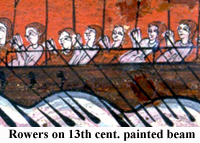
Rowers - The rowers (remerii) were predominantly recruited from Sicily and the surrounding
islands. The rowers were divided into different groups with specific tasks
on board the galley. The 2 shipwrights assigned large galleys were also
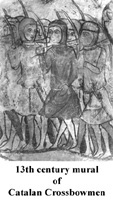 rowers. As the rowers were expected to fight, they generally wore a
leather cuirass and carried a buckler and short sword.
rowers. As the rowers were expected to fight, they generally wore a
leather cuirass and carried a buckler and short sword.
Crossbowmen - The Catalan balistarii
were the best and most feared crossbowmen in the Mediterranean, the Genoese not withstanding.
They were highly prized and the Office of the Admiral went to great
lengths to recruit them. By fleet regulation they carried 2 types of
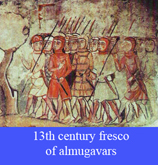 crossbow, an iron helm or cap, a leather cuirass and a short sword. These
men were veterans of the border wars with Castile and formed an important
part of an amphibious force.
crossbow, an iron helm or cap, a leather cuirass and a short sword. These
men were veterans of the border wars with Castile and formed an important
part of an amphibious force.
Almugavars - These light infantry were mercenaries recruited from the
border areas of the Crown of Aragon. They had a fearsome reputation as
fighters and could travel long distances with a minimal amount of food. They
typically had only light leather armor, a javelin, a dart, and short sword. All of
their food was carried in a small rucksack. They served as marines on
board the galleys and were an important component of the amphibious units.
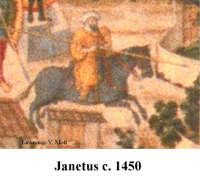
Janeti - These were mercenary units of light cavalry composed predominantly of
Muslims recruited from Valencia and Granada. They formed a screening
and scouting force for the amphibious units. They wore light armor and
carried a javelin of light spear. They were valued by the
Office of the Admiral, which paid for not only the transport of their
horses but their families as well.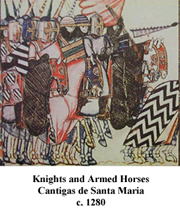
Stipendarii - The term strictly refers to 'men paid for a service' but the term in the fleet accounts refers to the typical medieval knight with a couched lance and wearing a helm and chain mail. These were the shock troops of an amphibious force. Unlike the janeti, who rode light roncini, the knights rode heavy destriers which were frequently 'armed', having barding or even chain mail.
When all of the above units were combined, Roger of Lauria could assemble a formidable amphibious force that could strike and retire quickly using the specialized galleys of the fleet. To learn more about the crews, mercenaries, horses and amphibious units of the fleet, their recruitment and pay see: Sea Power in the Medieval Mediterranean: The Catalan-Aragonese Fleet in the War of the Sicilian Vespers. Pictures from the Cantigas de Santa Maria are courtsey of the Patriomonio Nacional de España. Photographes of the Catalan crossbowmen and almugavars are courtesy of the Institut Amatller d'Art Hispanic in Barcelona.
The cross-section of the galley is based on: Pryor, John. "The galleys of Charles I of Anjou King of Sicily: 1269-84." Studies in Medieval and Renaissance History XIV (1993): 35-103.

